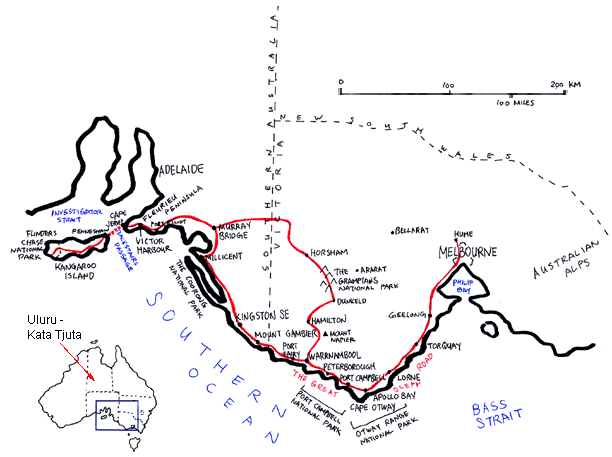 |
|

[2001] A deep impression down under -- The map above is drawn straight from memory four days following my return, with no further aid of other maps. It shows how deeply I am impressed by this vast, ancient and beautiful land, populated by people with a warm, open disposition from all over the world. The geographical names, mostly Anglo-Irish derivatives with some Aboriginal and French accents, are quite easy to remember.
Each morning, the Aussie steak sandwich with "the lot" (fried egg, grilled onions, mushrooms, beets and cabbage, slice of cheese, cooked to order for $4.50/$2.70 US) sustained my long drives and walks. Two memorable dinners were a sumptuous T-bone steak special at the Mount Gambier Hotel for $8.95 ($5.37 US!), and a huge take-away cray, or lobster, covetously consumed with a fried grand grenadier for $32.00 ($19.20 US) in Warrnambool.
In the evening, exhaustion and my fear of making road kills of wallabies and kangaroos kept me in my motel room, where I wrote my journals and watched CNN, cricket and soccer.
- Day 1, Sunday 18 November
- Arrival at Melbourne
- Day 2, Monday 19 November
- Melbourne to Mount Gambier, along the Great Ocean Road
| "The Big Lobster" at Kingston SE, Southern Australia | |
| Pink Lake off the Coorong, Southern Australia | |
| Granite Island off Victor Harbour, Southern Australia |
| McKenzie Falls at the Grampians, Victoria | |
| Mount Napier near the Grampians, Victoria | |
| Victoria Valley at the Grampians, Victoria |
- Gear - Canon G1 Digital, Nikon F100 with Nikon f2.8 20mm and f2.8 60mm Micro, Tamron 200-400mm f5 zoom
- Transport - '01 Toyota Camry, 4-cylinder, Sealinks "Sea Lion 2000" Catamaran and Coach (Kangaroo Island)
[2004] The heart of the southern continent -- When it comes to Australia, two landmarks dominate the world's collective consciousness: the Sydney Opera House and Uluru, or Ayers Rock, the sandstone monolith revered by the native Anangu people for 15,000 years. This is true for an online resource I used to apply for the Australian tourist visa; the two icons blink repeatedly on the title banner of www.australianvisas.net, which is actually based in the UK.
I got to see both during a brief diversion from my holidays in New Zealand, even if Sydney Harbor was only a distant view from my plane arriving and leaving Sydney. For Uluru, my compact itinerary at first prompted me to give in to the commercial treatment of this ancient, hallow place.
The open-air gourmet dinner was less than stellar (due in part to the overcast sky), and the helicopter flights were cancelled. It might be just as well, for the best parts of this visit were to make some friends, and join them in a comfortable walk amid the sacred rocks, as the rain clouds shielded the winter visitors from the harsh desert sun.
| Uluru (Ayers Rock) | |
| Valley of the Winds, Kata Tjuta (The Olgas) |
- Gear - Nikon D100 with Nikon f2.8 20mm and f2.8 60mm Micro
- Transport - '04 Mitsubishi Magna (Galant), Qantas flights between Sydney and Ayers Rock Resort (Yulara)
- Base - Outback Pioneer Hotel and Lodge, at the Ayers Rock Resort
| Back to top |

